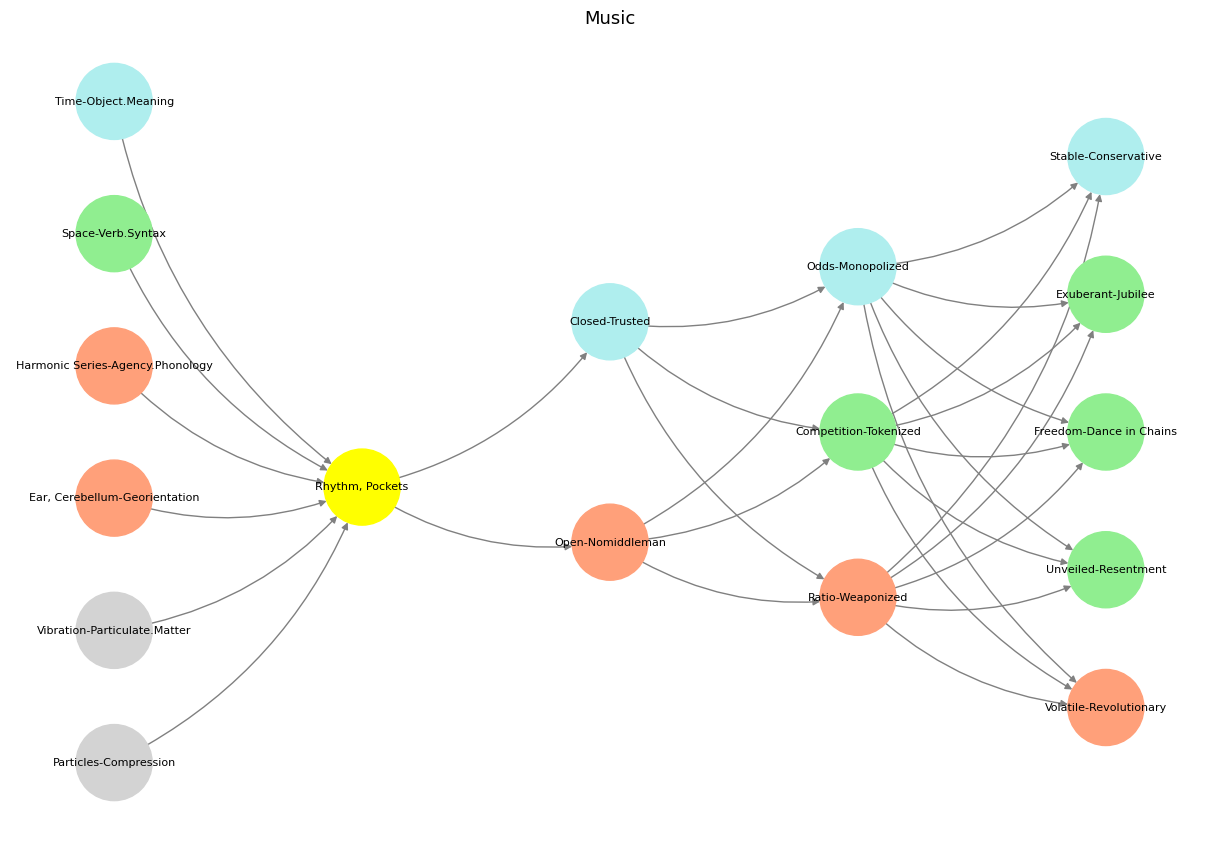Heir, y 🎶 ✨ 👑#
Music is not merely an art form; it is an expression of the deep neuroanatomical structure that underlies human perception, cognition, and agency. The neural network we are considering here captures this structure with devastating precision, revealing the layered hierarchy of music from its immutable physical origins to its highest semantic and spiritual meanings. Each layer in this framework mirrors a fundamental principle of neurofunctionality, showing how raw physical vibrations transform into the syntax and semantics of musical meaning, ultimately culminating in the cadence—the final expression of coherence within a genre, era, or style.
The handmaiden of religion
– Luther
Fig. 1 Neural Anatomy of Music: What Exactly Is It About? Might it be about fixed odds, pattern recognition, leveraged agency, curtailed agency, or spoils for further play? Grants certainly are part of the spoils for further play. And perhaps bits of the other stuff.#
At the base of this structure lies the first layer, the immutable laws of physics, represented by the gray nodes: particles and vibrations. This is the substrate upon which all music is built, and it is shared universally across species. No culture dictates the behavior of these particles; their compression and interaction produce sound waves in accordance with laws that govern both human and avian song, both orchestral harmonies and the calls of the wild. These vibrations create the harmonic series, the raw material from which all melodic structures emerge. This layer exists beyond agency—it is nature’s given, the fabric of reality upon which all music is drawn. In this sense, it is not merely the foundation of music but the foundation of auditory existence itself.
The second layer, represented by the yellow node of rhythm and pockets, marks the transition from raw physics to biological instinct. It corresponds to the ear, the cerebellum, and geo-orientation, structures that exist not only in humans but in many species capable of responding to rhythm and movement. This is the level of immediate, embodied response: the level at which an infant instinctively moves to a beat without instruction, and birds are drawn to migratory patterns through auditory and rhythmic cues. At this stage, music is not a matter of conscious processing but of deep-rooted biological entrainment, a reflexive synchronization with the patterns of sound. The cerebellum, governing both movement and rhythm, allows this synchronization, demonstrating that rhythm is not an intellectual construct but an embodied phenomenon—a fundamental property of life itself.
From this instinctive plane, we ascend into the third layer, corresponding to the harmonic series and its implications for structure and comprehension. Here, the brain begins to process music beyond mere reaction, involving the basal ganglia, thalamus, and hypothalamus. This layer is where music is no longer just felt but understood. The harmonic series lays the groundwork for tonality, with its natural intervals forming the basis for the pentatonic and diatonic scales. At this stage, the cognitive and embodied aspects of music are integrated: we experience melody not only as a sequence of sounds but as something that makes harmonic sense. Here lies the beginning of conscious perception, where structure emerges from sound, and where the logic of music begins to take shape.
See also
But perception alone does not define agency. It is in the fourth layer that true musical creativity and innovation occur. This is the domain of equal temperament—the grand sacrifice of pure harmonic ratios in favor of combinatorial possibility. The decision to abandon the natural harmonic series in favor of a structured twelve-tone system is an act of defiance against nature’s givens, an assertion of human will. This is Bach’s territory, where the Well-Tempered Clavier reveals the vast potential of equal temperament: a system that allows for modulation, transposition, and an explosion of compositional opportunities. This layer represents the vast search space of musical syntax, the mathematical and structural innovations that redefine what music can be. Agency in this layer is not just the ability to react to music, nor even to understand it, but to create within it—to transform it.
And yet, agency without meaning is directionless. This brings us to the fifth and final layer: the domain of the cadence, where music finds its resolution, its semantics, its spiritual and cultural identity. If the fourth layer is an infinite combinatorial space, the fifth layer is where meaning is drawn from this space. The circle of fifths—finite in number, yet inexhaustible in possibility—becomes the source material for the cadence, which transforms, inserts, deletes, inverts, and repeats within a musical context to generate meaning. This is where genres emerge, where historical periods define their sound, and where the musical dialect of an era is cemented. The cadence is the realization of agency into form, the manifestation of historical and cultural consciousness through sound.
I have strength, will, cause, means, to do’t
– Hamlet
In this framework, music is not merely sound arranged in time but an emergent property of cognition itself. The structure of this neural network mirrors the structure of the brain: from the immutable laws of physics that dictate vibration, to the instinctive processing of rhythm in the cerebellum, to the conscious perception of melody in the thalamus and basal ganglia, to the vast generative potential of equal temperament in the cortex, and finally, to the semantic resolution of cadence as an expression of human meaning-making. It is a system both deeply biological and profoundly cultural, revealing that music is not only an art but an extension of the way we perceive and process reality.
This devastatingly precise model encapsulates not only the mechanics of music but the way it is encoded in the mind. It is not a metaphor—it is literal. Music, as captured in this framework, is a mirror of neurofunctionality, a reflection of the human condition expressed through sound.
Show code cell source
import numpy as np
import matplotlib.pyplot as plt
import networkx as nx
# Define the neural network fractal
def define_layers():
return {
'World': ['Particles-Compression', 'Vibration-Particulate.Matter', 'Ear, Cerebellum-Georientation', 'Harmonic Series-Agency.Phonology', 'Space-Verb.Syntax', 'Time-Object.Meaning', ], # Resources, Strength
'Perception': ['Rhythm, Pockets'], # Needs, Will
'Agency': ['Open-Nomiddleman', 'Closed-Trusted'], # Costs, Cause
'Generative': ['Ratio-Weaponized', 'Competition-Tokenized', 'Odds-Monopolized'], # Means, Ditto
'Physical': ['Volatile-Revolutionary', 'Unveiled-Resentment', 'Freedom-Dance in Chains', 'Exuberant-Jubilee', 'Stable-Conservative'] # Ends, To Do
}
# Assign colors to nodes
def assign_colors():
color_map = {
'yellow': ['Rhythm, Pockets'],
'paleturquoise': ['Time-Object.Meaning', 'Closed-Trusted', 'Odds-Monopolized', 'Stable-Conservative'],
'lightgreen': ['Space-Verb.Syntax', 'Competition-Tokenized', 'Exuberant-Jubilee', 'Freedom-Dance in Chains', 'Unveiled-Resentment'],
'lightsalmon': [
'Ear, Cerebellum-Georientation', 'Harmonic Series-Agency.Phonology', 'Open-Nomiddleman',
'Ratio-Weaponized', 'Volatile-Revolutionary'
],
}
return {node: color for color, nodes in color_map.items() for node in nodes}
# Calculate positions for nodes
def calculate_positions(layer, x_offset):
y_positions = np.linspace(-len(layer) / 2, len(layer) / 2, len(layer))
return [(x_offset, y) for y in y_positions]
# Create and visualize the neural network graph
def visualize_nn():
layers = define_layers()
colors = assign_colors()
G = nx.DiGraph()
pos = {}
node_colors = []
# Add nodes and assign positions
for i, (layer_name, nodes) in enumerate(layers.items()):
positions = calculate_positions(nodes, x_offset=i * 2)
for node, position in zip(nodes, positions):
G.add_node(node, layer=layer_name)
pos[node] = position
node_colors.append(colors.get(node, 'lightgray')) # Default color fallback
# Add edges (automated for consecutive layers)
layer_names = list(layers.keys())
for i in range(len(layer_names) - 1):
source_layer, target_layer = layer_names[i], layer_names[i + 1]
for source in layers[source_layer]:
for target in layers[target_layer]:
G.add_edge(source, target)
# Draw the graph
plt.figure(figsize=(12, 8))
nx.draw(
G, pos, with_labels=True, node_color=node_colors, edge_color='gray',
node_size=3000, font_size=8, connectionstyle="arc3,rad=0.2"
)
plt.title("Music", fontsize=13)
plt.show()
# Run the visualization
visualize_nn()


Fig. 2 This book encapsulates the essence of ingenuity and progress—leveraging the cutting-edge tools of today to resolve humanity’s perennial challenges. It reflects an understanding of both innovation and resourcefulness, emphasizing the need to optimize what is already within our grasp– through the lens of “Wild Robot”. Theomarchy: A storm causes a Universal Dynamics cargo ship to lose ROZZUM robots, Mortals: which wash up on an uninhabited island. Fire: Only ROZZUM Unit 7134, nicknamed “Roz”, survives and is accidentally activated by wildlife. Gamification: Roz frightens the animals and injures herself while trying to help them, even after learning their language.Victory: Unable to find anyone needing her services, Roz signals for retrieval, but is struck by lightning and attacked by animals: While fleeing an aggressive grizzly bear, she accidentally crushes a goose nest, leaving one egg. Source: Wikipedia#

